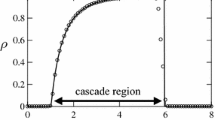Abstract
This article provides a simple model to value a credit swap ofthe basket type. Unlike the previous literature, we considerthe joint survival probability of occurrence times of creditevents in terms of stochastic intensity processes under the assumptionof conditional independence. Based on the joint survival probability,such a credit swap can be valued under the risk-neutral valuationframework. Assuming that the default intensity processes followthe extended Vasicek model with a correlation structure, an analyticexpression of the valuation formula is derived. Some numericalexample is given to demonstrate the usefulness of our model.
Similar content being viewed by others
References
Das, S. R., and P. Tufano. (1996). “Pricing Credit-Sensitive Debt when Interest Rates, Credit Ratings and Credit Spreads are Stochastic,” Journal of Financial Engineering 5, 161–198.
Duffie, D. (1998). “First-to-Default Valuation.” Working paper, Stanford University.
Duffie, D. (1999). “Credit Swap Valuation,” Financial Analyst Journal (January/February), 73–87.
Duffie, D., and K. Singleton. (1997). “An Econometric Model of the Term Structure of Interest Rate SwapYields,” Journal of Finance 52, 1287–1321.
Duffie, D., and K. Singleton. (1999). “Modeling Term Structures of Defaultable Bonds,” Review of Financial Studies 12, 687–720.
Hull, J., and A. White. (1990). “Pricing Interest-Rate-Derivative Securities,” Review of Financial Studies 3, 573–592.
Inui, K., and M. Kijima. (1998). “A Markovian Framework in Multi-Factor Heath-Jarrow-Morton Models,” Journal of Financial and Quantitative Analysis 33, 423–440.
Jarrow, R. A., D. Lando, and S. M. Turnbull. (1997). “A Markov Model for the Term Structure of Credit Risk Spread,” Review of Financial Studies 10, 481–523.
Jarrow, R. A., and S. M. Turnbull. (1995). “Pricing Options on Financial Securities Subject to Default Risk,” Journal of Finance 50, 53–86.
Karlin, S., and H. M. Taylor. (1981). A Second Course in Stochastic Processes. New York: Academic Press.
Kijima, M. (1999). “A Gaussian Term Structure Model of Credit Risk Spreads and Valuation of Yield-Spread Options.” Working paper, Tokyo Metropolitan University.
Kijima, M., and K. Komoribayashi. (1998). “A Markov Chain Model for Valuing Credit Risk Derivatives,” Journal of Derivatives 6, Fall, 97–108.
Kijima, M., H. Li, and M. Shaked. (2000). “Stochastic Processes in Reliability.” In C. R. Rao and D. N. Shanbhag (eds.), Stochastic Processes: Theory and Methods.
Kijima, M., and Y. Muromachi. (2000). “Credit Events and the Valuation of Credit Derivatives of Basket Type,” Review of Derivatives Research 4, 53–77.
Lando, D. (1994). “Three Essays on Contingent Claims Pricing.” Ph.D. Thesis, Department of Statistics, Cornell University.
Madan, D., and H. Unal. (1998). “Pricing the Risks of Default,” Review of Derivatives Research 2, 121–160.
Madan, D., and H. Unal. (2000). “ATwo-Factor Hazard Rate Model for Pricing Risky Debt and the Term Structure of Credit Spreads,” Journal of Financial and Quantitative Analysis 35, 43–65.
Stoyanov, J. (1987). Counterexamples in Probability. New York: Wiley.
Author information
Authors and Affiliations
Rights and permissions
About this article
Cite this article
Kijima, M. Valuation of a Credit Swap of the Basket Type. Review of Derivatives Research 4, 81–97 (2000). https://doi.org/10.1023/A:1009628513231
Issue Date:
DOI: https://doi.org/10.1023/A:1009628513231




